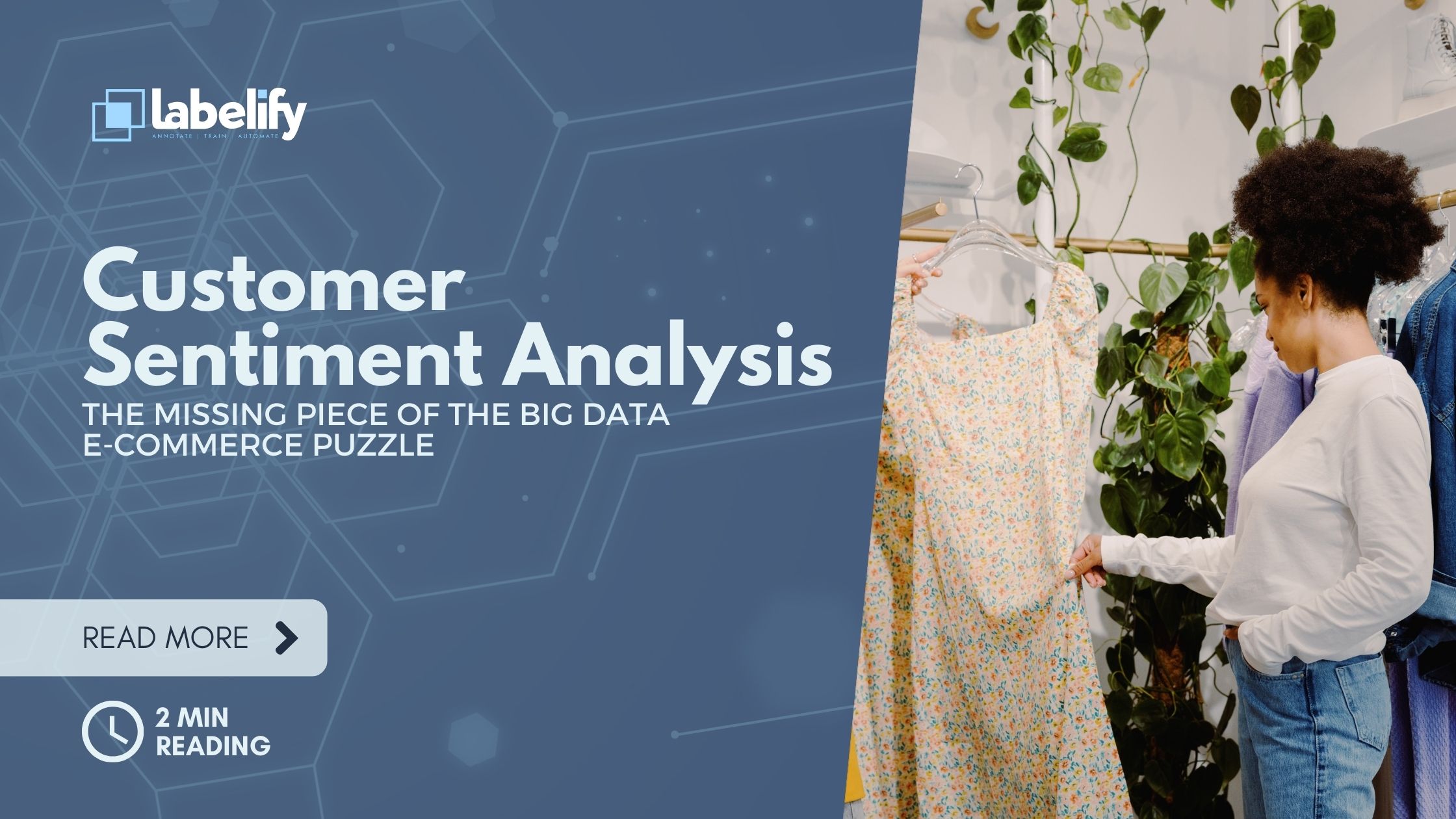Customer Sentiment Analysis: The missing piece of the Big Data E-handel puzzle
Customer opinion is vital to consumer brand success. Move beyond positive and negative, to find the real tone of what’s been said.
Experts estimate that E-commerce companies lose 10 billion dollars’ worth in revenue per year as they are unable to capitalize on the intelligence found in hard-to-parse data such as emails, chats, social media posts, text and more.
However, savvy companies are embracing the need to extricate data as a competitive advantage to determine customer needs and predict their behavior.
“We are drowning in information, but we are starved for knowledge.”— John Naisbitt, The New York Times bestselling author
When a company takes the online route to sell products, it knows that the Internet is the largest source of direct, immediate and unembellished market revenue. Once the e-commerce store is set up – to complement it perfectly, it sets up Facebook, Twitter, Pinterest and a Blog, to reach potential customers across all possible channels.
Sales go up and dreams get bigger….however… one foul little review on a product can jeopardize a chunk of following; a small scrape that starts to bleed, and before one knows it becomes a nasty wound.
The Social Paradigm
Every day, millions of online users post their opinion on product features, benefits and the value of products to express their feelings and attitudes on various channels. This ‘opinion’ or ‘sentiment data’ – subtly generated often include vital data points that can be invaluable for businesses looking to improve their customer experience, products or services.
The E – Commerce industry considers social media advertising as an integral parameter for progress for it ensures that visitors spend a good amount of time on the portal, searching for products they like, making purchasing and reviewing the purchased products positively on social media and returning to the portal for future purchases.
Social data is also instrumental in identifying the customers in the right demographic, psychographic and lifestyle group for each product purchase, and in making more informed decisions, and promoting brands.
What exactly is Sentiment Analysis?
Google defines sentiment analysis as “the process of computationally identifying and categorizing opinions expressed in a piece of text, especially in order to determine whether the writer’s attitude towards a particular topic, product, etc. is positive, negative, or neutral”.
That means, it involves the study of opinionated phrases or text where people are exchanging dialogue online, and label it as positive, negative or neutral. Unlike factual information, opinions and sentiments have one important characteristic, namely, they are subjective and hence need to be studied in larger numbers.
- Eg: Consider a tweet: “iPhone 6 can’t get a whole lot better”
- Polarity: Positive
- Relevance: 63.77%
- Frequency: 42 033
- Posts: 35 896
Powered by semantic analysis one can identify true-to-life sentiment tagged to people, places, objects, and brands. Here the words “a whole lot”, “better”, “can’t get” reinforces the positive sentiment.
The challenge to e-commerce success with sentiment data lies in the ability to mine the vast stores of unstructured social data for actionable insights, which is indeed a formidable task and requires sophisticated NLP (Natural Language Processing), statistics, or machine learning methods to characterize and capture the sentiment value.
In this context, linguistic functionalities become part of and complement the existing workflows and product suggestions (recommendations) in any major e-commerce search engine to meaningfully improve the quality of search results.
Below is a look at how businesses can find value in sentiment analysis data.
Enhanced Customer Experience
Customers who come back are those who feel they are being treated well throughout the buying journey. Sentiment Analysis can uncover customer attitudes on services, products, campaigns or detect their tone and temperament, on each and every word found in a customer’s social postings – and categorize them as either positive, negative or neutral.
Just as doctors can measure the acoustic characteristics of a telephone caller, i.e. the physical stress in his voice, and rate of speech, and help measure the overall context of the conversation to determine the true meaning behind spoken words; companies can use insights drawn across social networks to take actionable steps to improve the customers experience and the overall impression of their company.
Gain Competitive Edge by Quicker Response Times
More than 50 percent of customers on social media expect a response from companies in 60 minutes or less (and the no. is growing). Yes, you read it right. Nearly half of all your customers on social like to be ‘heard’ when it comes to social customer support, making quick response time as critical.
Sentiment analysis can pick up both negative and positive signals from their customers to read on how they’re doing and how they stack up with the competition. Knowing the sentiments associated with the brand, one can predict consumer trends and develop strategies to capitalize on those trends and gain a competitive edge.
Valuable Business Intelligence
Yet recent research by Social Bakers reveals that the majority of companies are falling short of meeting customer service expectations for the need of proper business intelligence.
Sentiment analysis data provides businesses with valuable and insightful information – about current and future customers – about newer business markets and possibilities – where companies can create actionable strategies by gaining this intelligence.
Intelligence insights need to be fused with human insights and other important metrics to create a whole picture.
Useful Tool for Market Research
Sentiment research can help companies spot emerging trends and discover newer markets. It can also help monitor events that are of strategic interest to your organization. For example, an organization can ask the following questions:
- Is the current market stable?
- Is your brand well-perceived and respected in the market?
- What opportunities are you missing?
- What new deals have come in?
- What customers are talking about?
- How to reach untapped customers?
Revitalize the Brand
Branding is all about how a customer perceives your company and its goals – and sentiment analysis allows you to quantify these perceptions. What do current and potential customers think across products and services, their consumer journey and experience, online content, marketing and social campaigns? In short, the overall brand.
Going forward, businesses who stand a chance to fully incorporate sentiment analysis are the ones who stand to gain greater business value and a distinct advantage over the competition.
At Labelify, we help e-commerce enterprises to derive valuable insights from tons of unstructured data available online. This exercise helps them understand how their brand is perceived by the target audience and aids in designing strategies to accomplish their brand, digital and revenue goals.




